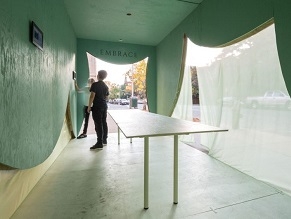|
World Jewish News

Sukkah in New York built to reconnect with refugees. (photo credit:ERIC PETSCHEK)
|
Brooklyn congregation dedicates sukkah to refugees
26.10.2016, Jews and Society Passers-by on the corner of Brooklyn’s 8th Avenue and Garfield Place this week couldn’t have missed the box-shaped hut outside of Congregation Beth Elohim, and on it, the words “We too were refugees.”
As synagogues across New York City have put up traditional succas for the holiday, the Park Slope neighborhood congregation decided to reconnect to the core meaning of Succot and use the opportunity to address what some have called the biggest issue of the decade: the refugee crisis.
The succa, built to resemble a refugee tent, shelters a long rectangular table, and on the walls, painted light green, small screens have been put up to display pictures and stories of five of the record number of 65 million refugees and displaced persons in the world today.
Congregation Beth Elohim is one of some 200 synagogues that have joined the Jewish organization HIAS, which is dedicated to protecting and helping refugees, in promoting its Welcome Campaign.
HIAS, which uses the motto “Welcome the Stranger, Protect the Refugee,” has been operating for over 130 years. It was founded in 1881 to assist Jews fleeing pogroms in Russia and Eastern Europe and resettling in the United States.
Since then, and particularly after the State of Israel was established and Jews no longer had to be refugees, HIAS’s activities have expanded to the larger refugee population.
The organization has become known as the US Jewish community’s voice on refugee issues.
By joining the Welcome Campaign, congregations like Beth Elohim pledge to take action and educate others about refugees, raising money for them and welcoming them into their own communities.
“Over the last year, many different populations in the United States Jewish community have really awoken to the global refugee crisis in a new way,” Rabbi Rachel Grant Meyer, the director of education for community engagement at HIAS, told The Jerusalem Post.
The Succot holiday, she added, is “a particularly meaningful moment to be talking about refugees.
“This is a holiday where Jews wrestle with and turn our awareness to our own fragility and to the impermanence of shelter. There is a natural connection between the way we are supposed to observe this holiday and the stories of contemporary refugees, who are definitely people who are aware of their own fragility,” she explained. In creating the refugee- themed succa in Brooklyn, Meyer said congregants get to reconnect with the true meaning of the holiday in a relevant way.
“Because of the tradition of inviting guests, or ‘ushpizin’ into the succa, we wanted to create a set of materials that would allow those celebrating the holiday to bring the stories, the actual words of refugees, into their succa as modern ushpizin,” she told the Post.
Designer Jennifer Hanlin, who created the succa, explained that her goal was to build something that would make people discuss the meaning of a succa, while making sure the basic religious elements of it were maintained.
“When you go to HIAS’s website, or even the United Nations websites about refugees, there is a lot of content and all of it is so important,” she said. “Originally, we had thought about putting portraits of refugees on the wall, but the content became so meaningful, so I thought about slide shows where you watch the screen and absorb layers of information.
“I wanted for people to feel a sense of intimacy with the stories,” Hanlin added. “You actually have to come close to the screen to really get the information, and I think that bringing your body close to the screen is an intimate experience.”
She kept some of the playful elements of a tent for children to enjoy, such as the curtains and the child-size opening at the back of the succa, while appealing to adults with the significance of the construction and inscriptions on each side.
Meyer said the succa at Congregation Beth Elohim is really a microcosm of a larger movement that has been unfolding over the past year among the Jewish community, which has been more and more open to learning about the ongoing refugee crisis, and even getting involved.
“More than anything else in the Torah, we learn that we have a responsibility to welcome the stranger, and not just to welcome them but also to protect and to love the stranger,” she told the Post. “That is really a foremost value of Jewish tradition, and unlike the other commandments in the Torah, we are actually given a reason for why we are supposed to welcome and love the stranger, and that is because we were strangers in the land of Egypt.”
Meyer added that the role of the Jewish community in helping refugees can be of great importance today.
“We’re in a unique moment,” she said. “This is the first time in history where Jews aren’t predominantly the refugees themselves, but we are really uniquely positioned to be able to help refugees today.”
Carla Weiss, a member of the Beth Elohim Congregation who helped create the presentations inside the succa, said the project has made her more curious about refugees.
“The stories that I read were so compelling because they put a face to the refugee crisis,” she said. “I’m definitely much more engaged, much more interested and willing to find out how I can help now.
“Being reminded about what it’s like to not have a home, especially with the political climate right now, now more than ever, it’s a great time for Jews to think how they can give back and share,” Weiss added. “The succa is our home for the week, everyone should have a home.”
By DANIELLE ZIRI
JPost.com
|
